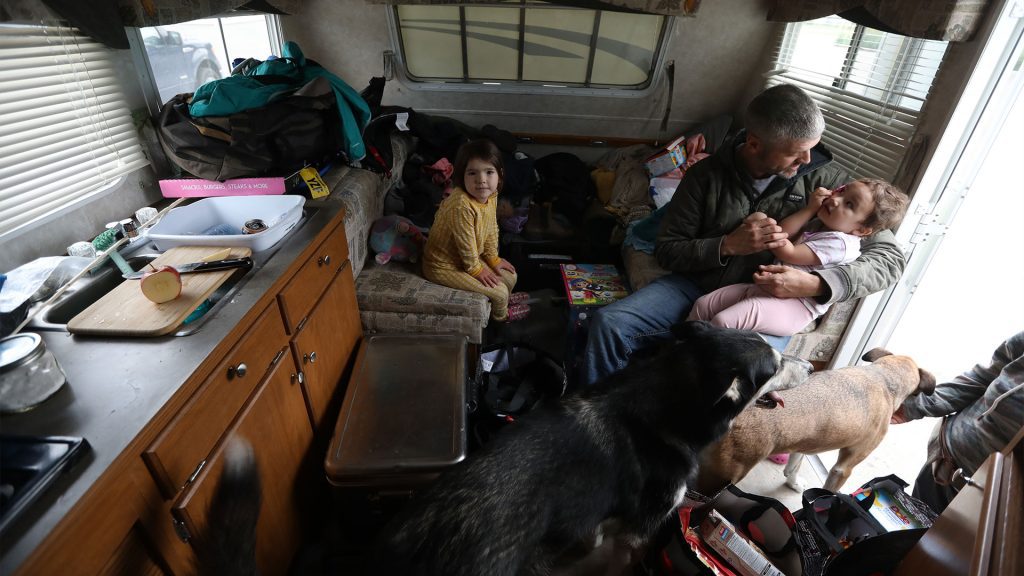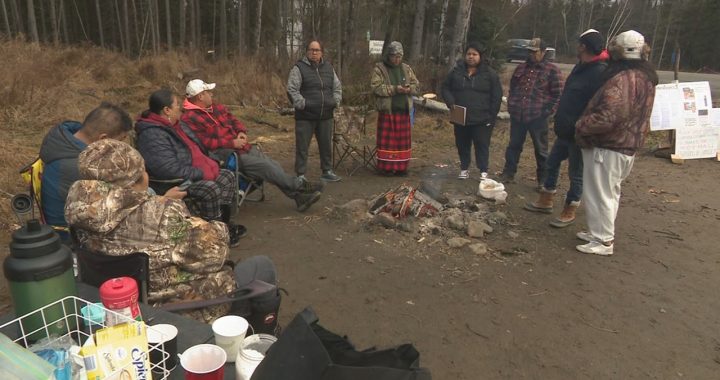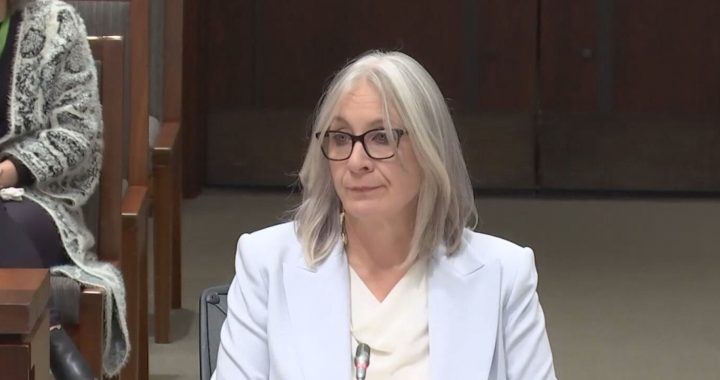
Hazel York, left, looks on as her father Stuart York holds her sister Hannah inside their travel trailer at the evacuation centre in Peace River, Alta., Friday, Aug. 18, 2023. York and his family were evacuated from Yellowknife due to wildfires. THE CANADIAN PRESS/Jason Franson
As wildfire evacuees from the Northwest Territories wait for word on when they can return home, some worry about how the stress will affect their communities long term.
“I was pretty strung-out and emotional,” Karl Johnston of Yellowknife revealed in an interview with APTN News.
“We were freaked out. We were panicking. We had a number of friends and family in the city and we were trying to reach everyone.”
Johnston said his stress ratcheted up after hearing that people travelling 250 km to Fort Providence, normally a two-and-a-half-hour trip, took nine hours.
He said the thick smoke made the situation seem even more harrowing.
“You couldn’t see 50 feet in front of you,” he said. “You could taste the smoke. It was stinging my eyes.”
Freda Cardinal, an evacuee from Hay River, could only get three words out.
“Sorry, so angry,” she replied when APTN asked her about her experience.
Evacuees have also been expressing their dissatisfaction online.
On TikTok, Francis Thasher said he and his family “we were waiting day after day for our government and our city to lay the evacuation for our city. We had a month of smoke.
“We heard that they flew out 100 people on a Hercules … you couldn’t convince me one or two Hercules planes was going to fly out everybody,” he added.
A growing body of international research suggests pollution from wildfire smoke can produce negative health effects that are compounded by multiple evacuations.
Research shows there are risks of cognitive deficits, post-traumatic stress and even an increase of dementia, Alzheimer’s and Parkinson’s diseases.
Mental health
Courtney Howard, an emergency physician in Yellowknife who researches wildfires, was in Ottawa when the evacuation order was issued for the Yellowknife hospital. She just happened to be speaking to colleagues at the Canadian Medical Association about the mental health effects of wildfires.
“I ended up wearing running shoes because it did not feel right to be standing there looking polished and professional when my colleagues were evacuating a 100-bed hospital,” Howard told APTN.
She has been staying with family members since the evacuation.
Nearly 137,000 square kilometres of land have been scorched this year in one of the worst for wildfires in Canada.
Currently, there are out-of-control wildfires in the Northwest Territories and British Columbia, forcing thousands of people from their homes.
Wildfire smoke is not only composed of vegetation from trees and other plants that are burned but also everyday products that are caught in the flames, including metals from vehicles and homes, plastic and clothes.
Howard has cared for evacuees during previous fires and says the stress can be powerful.
“We saw not a small number of alcohol-fuelled altercations and that sort of thing,” she said.
“There are few layers to it …,” she added. “We did a series of interviews after wildfires in 2014 and people described themes of anxiety, irritation, cabin fever and (a) sense of disconnection with the land.”
At the same time, Howard says researchers noticed a positive impact for those who prepared in advance and were able to help others.
“The people who prepare the most and contributed most to the community had a totally different tone … they sat up straight and were proud. They spoke in a way that you could tell they had felt a sense of meaning,” she says.
Evacuating with a disability
Johnston suffers from chronic nerve damage and says his disability made a long drive difficult.
“I also have a number of friends who are in wheelchairs … I was calling them, checking if they had heard if there was accessible transit, and they had not heard anything.”
He says he left with his family, but remained concerned about what would happen to those left behind.
APTN reached out to the City of Yellowknife for comment and was referred to the NWT government, which said it was unable to respond.
“When we got to Alberta we were in line for 2 km for gas,” said Johnston. “We got free gas which we were very appreciative of.”
But once they reached the town of High Level the spaces for evacuees were full.
“Since I have so much nerve damage in my legs … I can’t go on to Edmonton non-stop,” Johnston said. “Everywhere we went was full. It was 15 hours straight to Peace River.”
Read more:
NWT Fire service says fire unlikely to reach Yellowknife
Affect on the brain
Until recently, the effects of wildfires have been studied on patients’ lungs, hearts and blood. But several researchers have started looking into how fine particulate matter from wildfire smoke can enter the body and travel to the brain.
Kent Pinkerton, pediatrics professor at the University of California at Davis, said the nose is typically a good filter and keeps a number of inhaled particles out of the lungs.
But there is concern that tiny particles of soot and other chemicals in smoke have the ability to enter the cells and nerves of the nose, both of which scientists have shown have a direct connection to the brain.
Cells and nerves connecting the nose-brain passage, Pinkerton said, can get inflamed and damaged by wildfire smoke.
“Some particles from wildfire smoke have been shown to be able to cross the blood-brain barrier and cause inflammation of the brain,” he said in a recent interview with The Canadian Press.
Ray Dorsey, a neurology professor at the University of Rochester, New York, said some of the particulate matter from wildfire smoke is small enough that it can travel into the smell centres of the brain.
“Hitchhiking on these tiny particulate matter are pieces that are toxic metals, lead from leaded gasoline, iron from brake pads, and platinum from catalytic converters,” he noted.
Brains of people with Parkinson’s and Alzheimer’s show higher concentrations of heavy metal, Dorsey said. Damage to the smell centres of the brain is found almost universally in patients with these two diseases.
“It may be that this particulate matter entering into our nose and the gateway to our brain, which is normally protected by a blood-brain barrier, is getting exploited by the front door.”
Dorsey pointed to a July 2018 study published in the journal Environmental Research in which a group of international researchers found people exposed to air pollution in Mexico City showed Alzheimer’s and Parkinson’s signatures in their brains.
“Exposure to air pollutants plays a major role in the development and-or acceleration of Alzheimer’s disease,” said the study, called “Hallmarks of Alzheimer’s disease are evolving relentlessly in Metropolitan Mexico City infants, children and young adults.”
Dorsey said he’s seen recent reports suggesting air pollution from wildfires has a denser or higher concentration of particulate matter than air pollution from vehicle traffic.
“In short, whether you are a newborn baby or an older adult with Alzheimer’s disease, air pollution is likely harmful to your brain,” he said.
A study published in January in the journal PLOS Climate found that people exposed to smoke from the 2018 Camp fire, the deadliest and most destructive wildfire in California’s history, had “significantly” greater chronic symptoms of post-traumatic stress disorder, anxiety and depression than those who were not exposed to the fire.
“Studying cognitive abilities is important because they are core to all daily life functioning and can be key to understanding individual needs as they rebuild and rehabilitate in disaster-affected communities,” said the study.
Exposure to wildfires also caused a decrease in cognitive performance, which is the ability to suppress distractions and focus on the task at hand, said Jyoti Mishra, lead author of the California fire study and associate professor of psychiatry at the University of California, San Diego.
The study began six months after the wildfire and the smoke had subsided. The particulates could have entered the lungs at the height of the wildfires and affected the brain in a chronic way, she said.
“We don’t know that exact link as to how the particulates can affect the brain systems over the long term but what we found in a series of studies was that there was definitely prevalence of climate trauma.”
Community connection
Howard says the research papers all talk about the importance of community when it comes to resilience for wildfire evacuees.
“Cultural connection to one another and then to land is really really important elements of helping people’s mental health,” she said.
She told APTN that as a person who moved to the North as an adult, one of the major things she learned from the Indigenous communities were “really strong social fabric and a sense of community care,” she said.
“As people are thinking about coming home and coping in their evacuated communities … spend some time thinking about how they can renew those connections,” she said.
-With files from the Canadian Press









